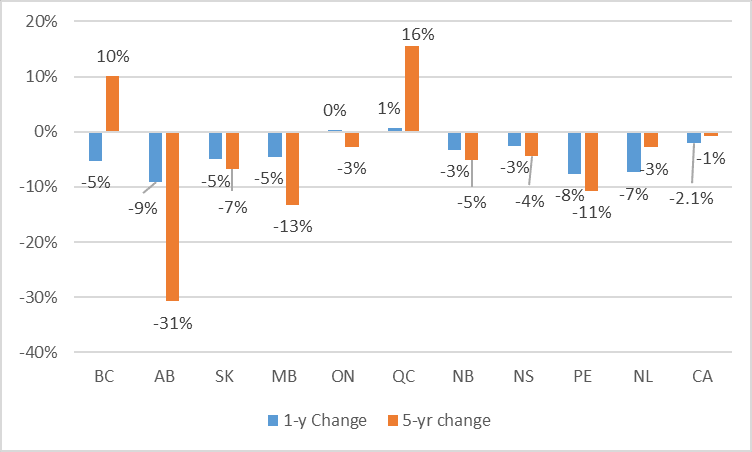All ten provinces have now issued their budgets, so it’s time for our annual look at how governments across the country are choosing to invest (or not) in higher education.
Just a quick reminder about how I do this. What I measure is budget commitments – that is, what governments say they are going to spend year over year. This is not quite the same thing as what they actually spend – there are always small differences between what governments budget and what goes out the door. So it’s not 100% accurate in terms of actual spending, but it’s pretty close and – big bonus – you can get the results instantaneously rather than waiting a couple of years for StatsCan to work out what actually happened.
Figure 1 shows the long-term picture for provincial transfers to post-secondary institutions, which is largely unchanged in real terms since 2008: never higher than $21 billion (in real $2022) and never less than $20 billion. Depending on your point of view, this could be regarded as admirable consistency or dangerous neglect.
Figure 1: Aggregate Budgeted Provincial Transfers to Post-Secondary Institutions, 2008-09 to 2022-23, in Billions of $2022.

This year, of course, the big story this year is that inflation is up. Way up. So even though nationally provincial spending is up by 4% in nominal dollars and only three provinces (Alberta, PEI and Newfoundland) saw nominal decreases in institutional funding, in real terms, only Ontario and Quebec saw increases (and in Ontario the increase is due entirely to a pre-election capital spending boost), and nationally, real government spending is down by 2.1%.
Figure 2: Real Change in Funding to Institutions, over 1- and 5-years, by Province, 2022-2023

But the more interesting piece here are the five-year changes in public financing. Nationally, the difference between 2017-18 and 2022-23 was only a decline of 1%. But in fact, what is going on is that significant funding increases in British Columbia (+10%) and Quebec (16%) have balanced out declines everywhere else (it is worthwhile noting that BC and Quebec have healthier balance sheets than other provinces) . Some of those declines have been small (-3% in Ontario) while others have been staggering (-31% in Alberta). So while Figure 1 is telling an important truth about the relative stability of aggregate changes in funding, it conceals the fact that within that stable national average funding in any given province may be on a roller coaster.
Turning in Figure 3 to student financial aid expenditures, we see a slow resumption of real growth in national student financial aid spending. However, this is entirely the result of the creation of a new set of grants in Quebec, which raised spending in that province by close to $190 million in real terms. In all nine other provinces, student aid budgets declined in real terms.
Figure 3: Aggregate Budgeted Provincial Expenditures on Student Financial Assistance, 2008-09 to 2022-23, in Billions of $2022.

Given the increased costs that most provinces will need to absorb through their subsidization of student loan interest as interest rates inevitably rise over the next few months, my guess is that most provinces are going to exceed their budgets this year,
Tomorrow: British Columbia in a Nutshell.

 Tweet this post
Tweet this post
